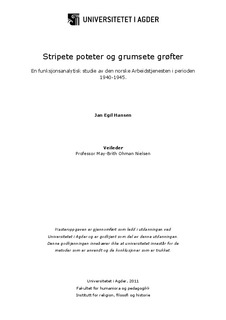| dc.description.abstract | This MA-thesis is a study of the Norwegian labor service (Arbeidstjenesten) during the five years of German occupation between 1940 and 1945. This thesis, which is the first of its kind, is based predominantly on primary sources found in the Norwegian National Archives (Riksarkivet). The main questions have been as follows: How did Arbeidstjenesten (A.T.) work, and what kinds of functions were assigned to it in the period 1940-1945? To what extent can A.T. said to have been a tool for Nasjonal Samling and the German occupation force, and to what extent did it perform work of social importance?
This study is based on a functional analytic approach similar to what Kiran Klaus Patel uses in his study Soldiers of Labor: Labor Service in Nazi Germany and New Deal America, 1933-1945 (2005). Patels study has been of great importance to this thesis due to his approach and how he defines labor services. He claims that the combination of education and work is the most important feature regarding labor services. Therefore I have focused on education and work, and the relationship between these two features in my study of Arbeidstjenesten. This thesis has also relied on the theories on total institutions first formed by Ervin Goffman, and later revised by Christie Davies. These theories have helped me to understand how A.T. worked and what kind of functions it performed.
Some 40 000 Norwegian men served and completed labor service between May 1941 and May 1945. Since A.T. in fact was organised by NS and the German occupation force, it is likely that it attempted to indoctrinate these men into a national socialist ideology, which they also did through various forms of education. Education as used here refers to what seeks to transform, change or in some other way alter or socialise individuals. All in all the education system in A.T. tried to do this, and was conceived as a way to create “Volksgemeinschaft”. A.T. also served as a way to gain both physical and political control over a large segment of the population. Therefore it can be described as an organ of stabilization and control.
Arbeidstjenesten was indeed intended as a tool for NS, but it did also perform work that was of social importance by contributing with manpower in the harvest and building roads. It performed work of military interest for the German occupation force only on two occasions. Since A.T. functioned both as a Nazi propaganda tool and as an organizer of important work, it represents shaded areas that often occur in wars. This caused various dilemmas concerning how one should perceive its activities, and makes A.T.s main functions in to a complex study. Some of these dilemmas are discussed in this thesis. | en_US |
